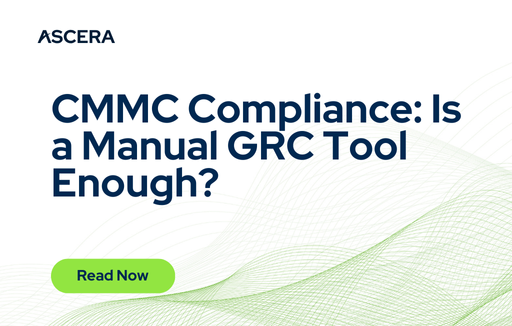GRC software is a tool for organizations seeking to streamline governance, risk, and compliance (GRC) in a cohesive and efficient manner.
By providing centralized data management, compliance tracking, and audit workflow processes, a GRC tool can help organizations navigate the complexities of today’s regulatory environment while enhancing overall operational efficiency if implemented effectively.
As security and compliance requirements continue to evolve, investing in a comprehensive GRC solution that fits your organization is not just a choice but a strategic necessity. But is a GRC tool enough for the growing demands of security frameworks like CMMC and NIST 800-171?
What is GRC Software?
Governance, Risk, and Compliance software helps organizations identify, assess, manage, monitor, and report risks associated with enterprise and compliance risks (Gartner).
GRC tools offer a centralized platform for managing governance, risk, and compliance activities, and can be applied to various GRC use cases and risk management workflows. However, many fall short in fully addressing the specific needs of cybersecurity GRC, often lacking the comprehensive functionality and automation required to effectively handle the dynamic and evolving nature of cyber risks, compliance obligations, and fast-changing IT environments frameworks, e.g., CMMC, NIST 800-171, DFARS, etc.
Traditional GRC capabilities include:
- Housing content from regulatory authorities including compliance mandates
- Allowing compliance professionals to manually enter data and upload evidence
- Assigning owners to security controls
- Offering built-in workflows, like informing control owners when tasks are overdue
- Facilitating risk analysis and prioritization
- Providing reporting functionality
How Does a GRC Help with CMMC Compliance?
There are many solutions in the market focused on cybersecurity GRC solutions and CMMC compliance. This is because the number of procedures and processes tied to achieving and maintaining CMMC compliance is overwhelming. Using an operations management tool can alleviate the burden of organizational stress. This is especially important because when there is stress, team members are spread too thin, etc., the risk of error increases exponentially.
The benefits of using a GRC tool for CMMC compliance include:
- Enhanced Visibility: By centralizing data and providing comprehensive dashboards, GRC software offers greater visibility into governance, risk, and compliance activities.
- Improved Efficiency: Automation of routine tasks such as risk assessments and reporting reduces manual effort and minimizes errors. This leads to more efficient operations and allows teams to focus on strategic activities.
- Streamlined Audits: The ability to track and manage audits within the software simplifies the audit process. It ensures that findings are addressed promptly and that audit trails are well-documented.
Limitations of a GRC for CMMC Compliance
While GRC tools can help streamline and organize efforts toward CMMC compliance, they also have their shortcomings.
1. Manual Data / Evidence Collection
GRC tools are typically updated manually, and this is a huge downside in the ever-changing compliance landscape. This needs to be done quickly, and automation is the reigning standard in expediting processes and efficiency.
Relying on third-party sources for data not only slows down collection and analysis, but it also guarantees that every piece of “new” information is actually outdated.
2. Inflexible Functionality
GRC tools come in many “shapes and sizes,” but an unfortunate majority are inflexible. As compliance standards and regulations evolve, tools must be able to keep up with the constant need for newer and updated frameworks.
On top of this, if GRC tools themselves aren’t evolving their own functionality, then a tool that might have the ability to address unlimited frameworks is still lacking the modern, innovative features users are looking for.
3. Lacking Risk Monitoring and Analysis / Continuous Controls Monitoring
GRC tools fall short when it comes to monitoring and analysis of not only risk, but data as a whole. So, data not only has to be entered into the tool manually, but GRC tools simply act as a repository, incapable of insightful analysis.
Real-time insight is where the market is at for numerous reasons. Monitoring the status of your environment compared to the compliance requirements and frameworks you’re adhering to is a vital function that GRC tools currently can’t provide.
Ways to Boost Your GRC’s Performance with ASCERA
While GRC tools are a wise investment, it’s clear they have their limitations. We believe users can still reap their benefits, while enhancing the areas GRCs tend to fall short. ASCERA is a next-generation cyber compliance software that automates many of the manual, administrative tasks of compliance. It does what GRC tools can’t and don’t do.
By integrating ASCERA with your existing GRC tools, you can supplement its performance with a variety of innovative and proactive features, including:
- Automating the collection and uploading of evidence
- Exporting all findings to a master evidence repository or Excel output
- Continuously monitoring and updating the status of individual security controls as Met (Compliant) or Not Met (Non-Compliant)
- Providing automated, real-time cyber compliance risk reporting to executives
- Reducing the time, cost, and risk associated with cyber compliance
Get Started with ASCERA
Ready to take your GRC tool’s performance to the next level? Schedule a free ASCERA demo today and see how you can transform your security compliance efforts and protect your organization.
